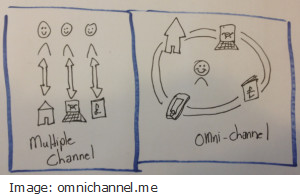The digital revolution has forever altered how customers and brands engage, The first casualty of this is change is the beaten path retailers used to attract customers, drive sales and define loyalty.
It’s all about the money, honey. Makes way for it’s all about the mobile, honey – engagement and 24/7 connectivity, as consumers search via multiple touch-points to find the best deals and products. Smartphones haven’t just changed the way shoppers used to locate, decide and make purchases, they are the way shoppers locate, decide and buy.
- For much of the 2014 holiday season, mobile shopping clicks exceeded those on the desktop indicating purchase decisions being made on the go.
An IDC study suggests that 71% of shoppers who use smartphones for product research in-store say that it’s become an important part of the experience – People use smartphones as their new personal shopping assistant inside the store.
What does this mean? Simply, that customer loyalty is not just about a single experience and it begins even before the first point of contact. For those retailers who want to stay relevant, understand this – customer loyalty today is now a derivation of – price, feedback from social channels, product availability, and convenience to name a few.
-That’s where analytics comes in…
One of the industry’s major game changers is retail analytics. With retail analytics, you are able to achieve a deeper understanding of the customer to enable retailers to engage customers real-time and gain a competitive advantage.
As technology has progressed the retail experience, too, has evolved from manual to digital. Enabling digital shopping lists, and computerized and customized reminders, which can include everything from food expiration dates to meetings and appointments. Additionally, as we advance to more digital experiences, in-store navigation and beacon technology have become fundamental to assist customers in their shopping experience. e.g, these technologies can help customers find desired items and quickly navigate the store as they receive personalized offers – all leading to a more engaged and satisfied customer
Mobile apps have also become ubiquitous (Want me to prove it…well there is an app for that too…) and an important enabler to customer engagement, providing boundless opportunities for customized content for brand-related events, store maps, personalized rewards, and shopping lists and customized coupons, while the customer is going about his planning outside of your store premise.
The enormous amount of data being generated through mobile apps – clickstream, behavioral & geo-location data when combined together generate possibilities of mapping the customers effectively to offers, meaningful product recommendations and personalization of experience. Not only does it make sense from a ROMI standpoint, but also provides a rewarding experience to the customer, fueling customer loyalty.
Customer preference for customized experiences is already validated. According to a combined study by Google, Ipsos MediaCT and Sterling Brands – 85% of shoppers are more likely to visit and purchase from stores that offer personalized coupons and exclusive offers provided in-store.
And as more retailers embrace the omni-channel strategy, we will see a vast amount of data flowing from multiple sources – the web (social media and e-commerce), various other digital platforms (app/mobile) and from the brick and mortar store transactions. The key here is to make sure you use this data efficiently to generate the right insight for targeted business decisions. And here is where analytics is the game changer – aiding decision making across functions:
- Merchandising: Store-layout planning or assortment optimization
- Supply Chain: Demand forecasting, inventory management, vendor management
- Marketing: Optimizing media and promotion spends, understanding consumer behavioral patterns
- Operations: Category management, fraud detection and loss prevention
- Human Resources: Effective work force allocations
Conclusion
Analytics can help retailers personalize effectively, picking from golden sawdust of data generated across channels. Whether selling online, in-store or both, this is where data comes into play, and what you do with the data will separate the winners from those who are just “figuring it out.” And when you engage your customer as an individual, you gain a distinct competitive business advantage as now you have earned your opportunity to successfully cross-sell and up-sell to the customer as you provided her an enhanced shopping experience.
Rachit Ahuja, AVP Global Marketing, Ma Foi Analytics
@racahuja






